Planning for Greater Dairy herd Profitability
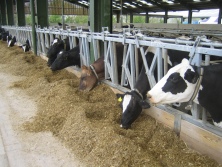 There has been much discussion of late about the best route for dairy farms to follow.
There has been much discussion of late about the best route for dairy farms to follow.
We are increasingly seeing those farmers who are committed to staying in the industry investing in improved farm infrastructure as well as rapidly improving their levels of efficiency and output in order to ensure their future prosperity.
Milk Yield and Efficiency Drive Profit
Herd size and milk price have less impact on dairy farm profitability than might be thought. Each dairy cow has very high fixed costs associated with it in terms of buildings, land and labour. The more milk that cow produces and the greater her feed efficiency the more profitable she is. Especially if the contribution made by home grown feeds is improved. This doesn't mean cutting concentrate costs it means, growing and conserving more and better quality forage. Feeding to meet the full nutritional requirements for the cows increased milk yield. As well as feeding and managing cows for improved herd health and greater rumen efficiency.
High Yielding Herds achieve Net Profit per Litre EQUAL to Lower Yielding Herds
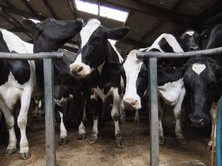 Read
the above statement again. It is generally assumed that higher yielding herds which by default generally
have higher feed inputs will produce a lower margin over concentrates per litre.
Read
the above statement again. It is generally assumed that higher yielding herds which by default generally
have higher feed inputs will produce a lower margin over concentrates per litre.
That may be true, but NET PROFIT PER LITRE on average is as good or better than for a lower yielding herd since fixed costs are spread across more litres. More milk results in a bigger milk cheque and more bottom line profit.
A full analysis of 330 UK dairy herds published in the DairyCo Milkbench Report 2012 suggests that on average a 9000 litre herd has the potential to produce 50% more profit than a 6000 litre herd of the same size. Feed and Forage accounted for only 1.0p/litre difference in costs between the Top 10% and Bottom 10% margin herds, whilst Labour, Machinery and Replacements accounted for 8.1p/litre difference. In other words it pays to feed for marginal litres. This principle is demonstrated quite clearly in Figure 1b, page 9 of the DairyCo Milkbench Report Profiting From Efficient Milk Production.
50% more profit from a 9000 litre herd than from a 6000 litre herd
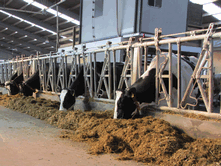 The
relationship between increased milk yield per cow and overall farm profitability is confirmed in the
DairyCo Milkbench Report 2013 in Figure 26, page 39 which clearly shows an upwards trend in net margin
per litre as milk yield increases from 6000 litres towards 11000 litres per cow. The point often missed
here is that the higher yield herds have more than double the output, at on average a higher net margin
per litre, so they achieve more than double the overall dairy farm profit. See the full report DairyCo
- Managing Costs 2013.
The
relationship between increased milk yield per cow and overall farm profitability is confirmed in the
DairyCo Milkbench Report 2013 in Figure 26, page 39 which clearly shows an upwards trend in net margin
per litre as milk yield increases from 6000 litres towards 11000 litres per cow. The point often missed
here is that the higher yield herds have more than double the output, at on average a higher net margin
per litre, so they achieve more than double the overall dairy farm profit. See the full report DairyCo
- Managing Costs 2013.
The DairyCo Milkbench report also demonstrates that the differences in production costs per litre between farms is even greater than differences in milk price. This highlights the massive scope for improving efficiency on many dairy farms. All cows have associated fixed cost. Providing that it is done efficiently, increasing milk yield per cow, generally increases variable costs per litre and reduces fixed costs per litre. Increasing milk yields leaves total cost per litre and net margin per litre relatively unchanged, but the increased milk output substantially increases total profit from the herd.
Feed for Cow Health and Milk Yield to Increase Profitability
In recent years within the UK Dairy Industry there has been far too much emphasis placed on keeping costs down and far too little emphasis placed on embracing new technology particularly with regard to feeding cows. This approach is actually holding back the profitability of many farms. The Milkbench report shows that feed and forage costs represent only 20% - 30% of milk income. In general spending more to feed cows better can improve herd health, fertility and milk output and lift overall farm profit.
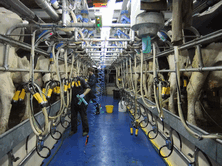 Farmers
who accept new ideas based on the results of sound research and who manage their farm as a
business will stay ahead of the game and will prosper. UK
dairy farms are now good sized businesses which require a high level of skill to be managed successfully.
Not only do farmers need to master a wide range of practical skills and have an expert knowledge of animal
and crop husbandry, be skilled machine operators and be capable of mending pretty well anything they
also need to be skilled business managers.
Farmers
who accept new ideas based on the results of sound research and who manage their farm as a
business will stay ahead of the game and will prosper. UK
dairy farms are now good sized businesses which require a high level of skill to be managed successfully.
Not only do farmers need to master a wide range of practical skills and have an expert knowledge of animal
and crop husbandry, be skilled machine operators and be capable of mending pretty well anything they
also need to be skilled business managers.
Focus on Milk Output and Feed Efficiency rather than Input Costs to Increase Profit
Make Full Use of Free Outside Advice
Many of the most successful and most profitable farms are increasingly recognising that one person cannot be expert in all areas and are working closely with a team of outside support specialists, including their nutritionist, agronomist, vet, and others. These people can be a valuable asset to your business. Trust them. Work closely with them. Make full use of them. Make them part of your team. The success of your business is important to the success of their business.
Time spent managing the business effectively is likely to yield a higher return for than any other task on the farm. This is where the money is made. Be discerning and seek out the best advice available. Good advice is worth its weight in gold.
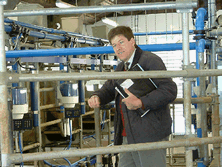 Be sure to allocate sufficient time to working with your team of advisors. Work
with people you trust, people who are acting in your best interest. It is in their interest
for the farm to prosper.
Be sure to allocate sufficient time to working with your team of advisors. Work
with people you trust, people who are acting in your best interest. It is in their interest
for the farm to prosper.
Develop close working relationships and act on advice of the people who know your farm and who are specialist in a particular area.
Consider the following:
1). Do you manage your farm as a business? Has "paperwork overload" been allowed to get in the way of planning your business? Do you know the cost levels in your business? Are your purchasing decisions based on quantifiable return on investment or do you buy purely on price?
2). Is your total output high enough? The biggest factor effecting profit on dairy farms is milk output. Milk output controls money coming into the business. Since labour is the biggest cost on most dairy farms, litres of milk per person is a useful benchmark. 300,000 litres per man at 25 p/litre amounts to �75,000 but after costs even if you achieve a profit of 5p/litre, 300,000 litres only equates to an income of �15,000 before tax. Not a lot if you work a 90 hour week.
A sensible target might be 500,000 litres per man, some herds
are achieving 750,000 litres plus
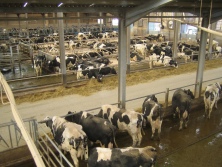 3). Could your system be simplified to allow an increase in cow numbers with the same labour?
Simplified feed systems and automation of routine tasks can dramatically reduce labour costs.
3). Could your system be simplified to allow an increase in cow numbers with the same labour?
Simplified feed systems and automation of routine tasks can dramatically reduce labour costs.
4). Are your cows producing over 9000 litres of milk? The cost of keeping a cow is typically between �1600 and �2000 per cow per year in the UK. Most herds in the UK could lift yields to over 9000 litres within 2 years by improved nutrition. Lifting yields through better forage and better nutrition can also improve herd health and fertility and reduce culling.
The argument for lifting milk yields goes something like this:
Assuming 100 cow herd with costs of �1680 per cow and allowing 10 p/litre to cover marginal feed and milking costs on additional litres.
Yield / Cow |
Profit (Milk Price 24p) |
Profit (Milk Price 28p) |
7000 |
Zero Profit |
£28000 |
8000 |
£14000 |
£46000 |
9000 |
£28000 |
£64000 |
10000 |
£42000 |
£82000 |
At 28 p/litre an increase of 1000 litres / cow is worth over
�18,000 additional profit per 100 cows
5). Have you set a target increase in yield? What timescale have you allowed? How will you monitor it? What steps have you taken to meet your target?
6). Could more efficient use of home grown forage or alternative feeds contribute towards achieving your target increase in yield at a lower cost?
7). Do you have access to the nutritional expertise and advice as well
as the quality and range of feed inputs necessary to achieve your target increase in milk output and
profitabili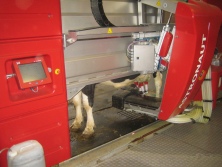 ty?
ty?
If the answer to all these questions is 'Yes', then you will probably have a very profitable business especially as milk prices rise in the future as a result of increased World demand.
Once you sit down and do some basic calculations it soon becomes clear that attempts to reduce variable costs such as feed inputs, forage additives etc. for most dairy farm businesses actually reduces profitability
Lifting milk output through improved nutrition can result in dramatic improvements in overall dairy farm profitability.
Richard Webster Nutrition Ltd offers a full nutritional support package to our customers Free of Charge, along with the most extensive range of high quality feed inputs available.
For more information or for an in depth consultation contact Richard Webster.
